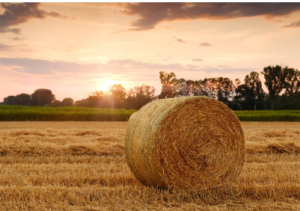Silage plastic is an indispensable tool for safeguarding hay or straw bales against moisture and external influences, helping preserve their nutritional value so they may be fed to animals as food sources.
 Bales must be stored on a gravel pad to keep plastic secure oil, which will minimise grit adhering to it and possibly adding to holes.
Bales must be stored on a gravel pad to keep plastic secure oil, which will minimise grit adhering to it and possibly adding to holes.
- Durability
Silage plastic sizes with high permeation rates can accelerate aerobic degradation at the top of a silo due to lower density and greater air exchange, increasing DM losses and yeast counts [9,10]. A lower oxygen permeance silage plastic, such as Mater-Bi polymer film – with its white hue, smooth surface, free from pores and limited solar heating – may help mitigate such issues and preserve silage quality during long conservation periods.
A silage plastic bale wrap film should be strong and resilient enough to withstand severe weather conditions while safeguarding a farmer’s investment. A suitable agricultural plastic should last at least 12 months in outdoor conditions without becoming damaged, maintaining fresh and nutritious forage on farms during winter and maintaining performance levels among livestock.
Regular inspection and replacement of silo bags are important to preventing oxygen from reaching and spoiling the forage. A silage bag should be secured using weights such as rubber tyres or sand-filled sacks to prevent it from flying away and leaving it exposed; plastic pieces must also be cut to manageable sizes for easier handling.
- Stability
Aerobic stability is key to successful silage production. Achieved through plastic sheeting or other means, aerobic stability prevents microbial spoilage while improving quality and decreasing storage losses – saving farmers money. Silage plastic can help achieve this result by restricting air entering and exiting from within its pile.
It also helps maintain a lower temperature inside, speeding fermentation and improving product quality, preventing oxygen from infiltrating the pile and damaging forage inside.
Silage bale wrap is non-toxic and free of chemicals that could harm animals or plants, making it safe to use on any farm without worrying about contaminating crops or harming animals; furthermore, its low impact makes it an excellent option for any feed source.
In assessing the efficacy of various silage plastic sizes in preventing air penetration and promoting aerobic stability, three types of silage were covered with either an OB film, standard PE film, or biodegradable polyamide film for 21 days, 85 days, 133 days or 195 days before samples were taken to measure fermentative characteristics, microbial counts and aerobic stability. It was found that the OB film proved more successful at encouraging aerobic stability than either PE or biodegradable film coverings.
- Oxygen Barrier
Silage plastics are designed to keep oxygen out, protecting the nutritional value of hay and grain crops while aiding the fermentation process, which preserves plant proteins and sugars for creating a high-quality feed for your livestock. Furthermore, this helps avoid mouldy forage, which could pose potential health concerns for cows or other livestock.
To use oxygen barrier film on a pit, silo or pile, begin by covering its top surface with Silostop Orange and placing cross-hatched Gravelbags around it with no gaps between bags – then add O2 Barrier 2in1 over all bags and clamp walls – this method prevents most rainwater running down between silage and side walls thus saving time and avoiding slurry formation.
- Stretchability
The use of plastic film for wrapping fodder can preserve its nutritional value while inhibiting harmful fermentation processes, creating forage that livestock and sheep will enjoy eating instead of producing silage that lacks vital vitamins and nutrients.
However, selecting the appropriate plastic film for this task is crucial. A high-quality hay bale plastic must withstand long hours of direct sunlight and sudden weather changes without degrading quickly or breaking down altogether; otherwise, it exposes silage to environmental harm and reduces quality significantly.
One way of protecting fodder is using stretch nylon designed to be highly elastic, which conforms perfectly to the shape of bales without creating any holes or gaps in their packaging. Furthermore, this material keeps oxygen out, helping prevent spoilage or mould growth and cutting costs by eliminating costly additives.
